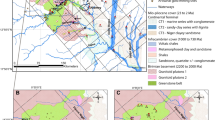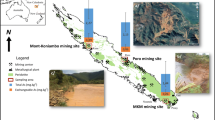Abstract
The Iron Quadrangle has been the scenery of the most important gold production in Brazil. It is estimated that during the three centuries of gold mining in the Iron Quadrangle, at least 390,000 t of arsenic was discharged into the drainage system. This study presents geochemical data for the three river basins in the region, with focus on surface water and stream sediment monitoring. Samples of primary and oxidized sulfide ores as well as of tailings and groundwater from the major gold mines were also studied. The highest As concentrations in water and stream sediments occur in the vicinity of mining areas. In surface water, up to 300 g As/l were found whereas the As contents in stream sediments were in the range of 20 to 4,000 mg/kg. The As3+/As5+ concentration ratios obtained for some water samples range from 1.10−1 to 4.10−2. The As mobility associated with ore-deposit weathering could be traced in some closed gold mines by observation of in-situ pyrite and arsenopyrite oxidation, precipitation of scorodite and gippsite, As adsorption onto goethite, and final liberation of As into underground and surface waters. This process is likely to produce large volumes of mine effluents containing total As and trivalent As up to 1,960 and 60 g/l, respectively. River sediments and tailings pile samples were submitted to a leaching procedure showing maximal arsenic release from 1 to 4% of the original total As in the samples. There are potential risks for As hazards in some areas induced by, for instance, the dispersion of old tailings by flooding, occupation of poisoned soils for settlements, and occasional consumption of contaminated surface and groundwater.




Similar content being viewed by others
References
Abreu AS, Diniz HD,Prado MGB, Santos SP (1988) Mina de Ouro de São Bento, Santa Bárbara, Minas Gerais. In: Schobbenhaus C, Coelho CES (eds) Principais depósitos minerais do Brasil. DNPM/CVRD, Brasilia, vol 3, pp 393–411
Anon (1986) Toxicity characteristic leaching procedure (TCLP), part 268 (40-CFR), appendix I. Federal Register 51, pp 40643–40650
Borba RP, Figueiredo BR, Rawllins BG, Matchullat J (2000) Arsenic in water and sediment in the Iron Quadrangle, Minas Gerais state, Brasil. Rev Brasil Geociê 30(3):554–557
Bowell RJ (1994) Sorption of arsenic by iron oxides and oxyhydroxides in soils. Appl Geochem 9:279–286
Cavalcanti JAD (1999) Mineralização aurífera de Lajes-Antônio Dias, Ouro Preto MG. Contrôles lito-estratigráficos e estruturais. MSc Thesis, Unicamp, São Paulo
CONAMA (1986) Resolução CONAMA no20 de junho de 1986. Resolução do CONAMA 1984/86. SEMA, Brasilia
Daus B, Mattusch J, Paschke A, Wennrich R, Weiss H (2000) Kinetics of the arsenite oxidation in seepage water from a tin mill tailings pond. Talanta 51(6):1087–1095
Dorr JVN II (1969) Physiographic, stratigraphic and structural development of the QF, Brazil. DNPM/USGS, Washington, Prof Pap 641-A
Dove PM, Rimstidt JD (1985) The solubility and stability of scorodite, FeAsO42H2O. Am Mineral 70:838–844
Drever JI (1997) The geochemistry of natural waters surface and groundwater environments, 3rd edn. Prentice Hall, Englewood Cliffs, NJ
Dzombak DA, Morel FMM (1990) Surface complexation modeling: hydrous ferric oxide, 1st edn. Wiley, New York
Eleuterio L (1997) Diagnóstico da situação ambiental da cabeceira da bacia do rio Doce, no âmbito das contaminações por metais pesados em sedimentos de fundo. MSc Thesis, UFOP, Brazil
Kim M, Nriagu J (2000) Oxidation of arsenite in groundwater using ozone and oxygen. Sci Total Environ 247:71–79
Krause E, Ettel VA (1988) Solubility and stability of scorodite, FeAsO42H2O: new data and further discussion. Am Mineral 73:850–854
Ladeira ACQ, Ciminelli V (2000) Mobility of As(III) and As(V) in soils. In: Courtney Young (ed) Minor elements 2000: processing and environmental aspects of As, Sb, Se, Te and Bi. Proc Conf Minor Elements 2000, Littleton. Society for Mining, Metallurgy and Exploration, Littleton, CO, pp 191–198
Matschullat J, Borba RP, Deschamps E, Figueiredo BF, Gabrio T, Schwenk M (2000) Human and environmental contamination in the Iron Quadrangle, Brazil. Appl Geochem 15:181–190
Nesbitt HW, Muir IJ, Pratt AR (1995) Oxidation of arsenopyryte by air and air-satured, distilled water, and implications for mechanism of oxidation. Geochim Cosmochim Acta 59(9):1773–1786
Oliveira FR (1998) Contribuição ao estudo da geologia estrutural e da gênese do depósito aurífero de Passagem de Mariana-MG. MSc Thesis, Unicamp, São Paulo
Oliveira JJC, Ribeiro JH, Souza Oki S, Barros JRR (1979) Projeto geoquímica do Quadrilátero Ferrífero: levantamento orientativo e regional. Relatório final, vol I. CPRM, Belo Horizonte
Parkhurst DI, Appelo CAJ (1999) User's guide to PHREEQC, version 2. A computer program for speciation, batch-reaction, one dimensional transport, and inverse geochemical calculations. US Geol Surv Water Resources Inv Rep 994259
Raposo FO, Ladeira E (1995) Padrões de terras-raras de algumas formações ferríferas arqueanas do QF. Terra Revista 1(0):19–23
Rawlins BG, Williams TM, Breward N, Ferpozzi L, Figueiredo BF, Borba RP (1997) Preliminary investigation of mining-related arsenic contamination in the provinces of Mendoza and San Juan (Argentina) and Minas Gerais State (Brazil). British Geol Surv Tech Rep WC/97/60
Reimann C, Ayräs M, Chekushin V, Bogatyrev I, Boyd R, Caritat P de, Dutter R, Finne TE, Halleraker JH, Jaeger O, Kashulina G, Letho O, Niskavaara H, Pavlov V, Raisänen ML, Strand T, Volden T (1998) Environmental geochemical atlas of the Central Barents Region. Geological Survey of Norway
Ribeiro-Rodrigues LC (1998) Gold mineralization in Archean banded iron-formation of the QF, Minas Gerais, Brazil. The Cuiabá Mine. PhD Thesis, RTWH Aachen
Robins RG (1987) The solubility and stability of scorodite, FeAsO42H2O: discussion. Am Mineral 72:842–844
Schreiber MJ, Simo J, Freiberg P (2000) Stratigraphic and geochemical controls on naturally occurring arsenic in groundwater, eastern Wisconsin, USA. Hydrogeol J 8:161–176
Shraim A, Chiswell B, Olszowy H (1999) Speciation of arsenic by hidride generation-atomic absorption spectometry (HG-AAS) in hydrochloric acid reaction medium. Talanta 50:1109–1127
Smith KS (1999) Metal sorption on mineral surfaces: an overview with examples relating to mineral deposits. Rev Econ Geol 6A:161–182
Terashima S, Taniguchi M (1998) Mineralogical associations of arsenic and antimony in thirty-five geochemical reference materials by sequential extraction with hydride generation and atomic absorption spectrometry. Geostand Newslett 22(1):103–112
USEPA (2000) Technologies and costs for removal of arsenic from drinking water. EPA Rep 815-R-00-028
Vial DS (1988) Mina de ouro de Cuiabá, QF, Minas Gerais. In: Schobbenhaus C, Coelho CES (eds) Principais depósitos minerais do Brasil. DNPM/CVRD, Brasilia, vol 3, pp 413–419
Vieira FWR (1988) Processos epigenéticos de formação dos depósitos auríferos e zonas de alteração hidrotermal do Grupo Nova Lima, Quadrilátero Ferrífero, Minas Gerais. In: Proc 35th Congr Brasileiro de Geologia, 6–13 November 1988, Belém. Sociedade Brasileira de Geologia, Belém, vol 1, pp 76–87
Vieira FWR (1991) Textures and processes of hydrothermal alteration and mineralization in the Nova Lima Group, Minas Gerais, Brasil. In: Ladeira EA (ed) The economics, geology, geochemistry and genesis of gold deposits. Proc Symp Brazil Gold'91, 13–17 May 1991, Belo Horizonte. Balkema, Rotterdam, pp 319–325
Vink BW (1996) Stability relations of antimony and arsenic compounds in the light of revised and extended Eh-ph diagrams. Chem Geol 130:21–30
Acknowledgments
The present study was carried out with the financial support of the Brazilian agency Fapesp (doctoral scholarship 97/14446-6 and research grant 96/7839-9). The authors are grateful to the staff of the Analytical Geochemistry Laboratory and of the SEM Multiusers Laboratory at Unicamp (Fapesp 95/6401-7). This project has also benefited from the analytical data provided by the geochemical laboratories of the British Geological Survey (Keyworth, Nottingham, U.K.) and of Heidelberg University, Germany.
Author information
Authors and Affiliations
Corresponding author
Rights and permissions
About this article
Cite this article
Borba, R.P., Figueiredo, B.R., Rawlins, B. et al. Geochemical distribution of arsenic in waters, sediments and weathered gold mineralized rocks from Iron Quadrangle, Brazil. Env Geol 44, 39–52 (2003). https://doi.org/10.1007/s00254-002-0733-6
Received:
Accepted:
Published:
Issue Date:
DOI: https://doi.org/10.1007/s00254-002-0733-6




